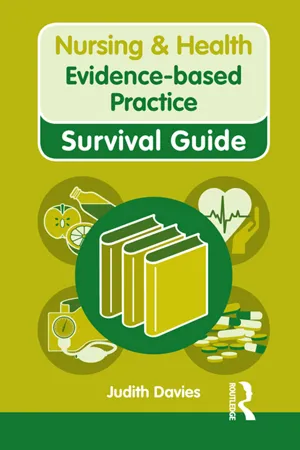
This is a test
- 76 pages
- English
- ePUB (mobile friendly)
- Available on iOS & Android
eBook - ePub
Nursing & Health Survival Guide: Evidence Based Practice
Book details
Book preview
Table of contents
Citations
About This Book
Taking an evidence-based approach is fundamental to ensuring good clinical practice, but it's not always easy. This info-packed guide will be an invaluable resource throughout your healthcare or nursing studies and post-registration, helping you to understand the essentials of EBP theory and application, and develop new insights into healthcare practice.
The Nursing & Health Survival Guides have evolved - take a look at our our app for iPhone and iPad.
Frequently asked questions
At the moment all of our mobile-responsive ePub books are available to download via the app. Most of our PDFs are also available to download and we're working on making the final remaining ones downloadable now. Learn more here.
Both plans give you full access to the library and all of Perlego’s features. The only differences are the price and subscription period: With the annual plan you’ll save around 30% compared to 12 months on the monthly plan.
We are an online textbook subscription service, where you can get access to an entire online library for less than the price of a single book per month. With over 1 million books across 1000+ topics, we’ve got you covered! Learn more here.
Look out for the read-aloud symbol on your next book to see if you can listen to it. The read-aloud tool reads text aloud for you, highlighting the text as it is being read. You can pause it, speed it up and slow it down. Learn more here.
Yes, you can access Nursing & Health Survival Guide: Evidence Based Practice by Judith Davies in PDF and/or ePUB format, as well as other popular books in Médecine & Prestation de soins de santé. We have over one million books available in our catalogue for you to explore.
Information
Critical Appraisal Skills Programme (CASP) – making sense of evidence
■ TEN QUESTIONS TO HELP YOU MAKE SENSE OF REVIEWS
How to use this appraisal tool
Three broad issues need to be considered when appraising the report of a systematic review:
• Is the study valid?
• What are the results?
• Will the results help locally?
The ten questions are adapted from Oxman AD, Cook DJ, Guyatt GH, Users’ guides to the medical literature. VI. How to use an overview. JAMA 1994; 272(17), 1367–1371.
SCREENING QUESTIONS | |
1. Did the review ask a clearly-focused question? Consider if the question is ‘focused’ in terms of: • The population studied • The intervention given or exposure • The outcomes considered | Yes □ Can’t tell □ No □ |
2. Did the review include the right type of study? Consider if the included studies: • Address the review question • Have an appropriate study design | Yes □ Can’t tell □ No □ |
Is it worth continuing?
DETAILED QUESTIONS | |
3. Did the reviewers try to identify all relevant studies? Consider: • Which bibliographics databases were used • If there was follow-up from reference lists • If there was personal contact with experts • If the reviewers searched for unpublished studies • If the reviewers searched for non-English-language studies | Yes □ Can’t tell □ No □ |
4. Did the reviewers assess the quality of the included studies? Consider: • If a clear, predetermined strategy was used to determine which studies were included. Look for: – A scoring system – More than one assessor | Yes □ Can’t tell □ No □ |
5. If the results of the studies have been combined, was it reasonable to do so? Consider whether: • The results of each study are clearly displayed • The results were similar from study to study (look for tests of heterogeneity) • The reasons for any variations in results are discussed | Yes □ Can’t tell □ No □ |
6. How are the results presented and what is the main result? Consider: • How the results are expressed (e.g. odds ratio, relative risk, etc.) • How large this size of result is and how meaningful it is • How you would sum up the bottom-line result of the review in one sentence | Write comments here … |
7. How precise are these results? Consider: • If a confidence interval were reported, would your decision about whether or not to use this intervention be the same at the upper confidence limit as at the lower confidence limit? • If a P value is reported where confidence intervals are unavailable | Write comments here … |
8. Can the results be applied to the local population? Consider whether: • The population sample covered by the review could be different from your population in ways that would produce different results • Your local setting differs much from that of the review • You can provide the same intervention in your setting | Yes □ Can’t tell □ No □ |
9. Were all important outcomes considered? Consider outcomes from the point of view of the: • Individual • Policy-makers and professionals • Family/carers • Wider community | Yes □ Can’t tell □ No □ |
10. Should policy or practice change as a result of the evidence contained in this review? Consider: • Whether any benefit reported outweighs any harm and/or cost. If this information is not... | |
Table of contents
- Cover
- Title Page
- Copyright Page
- Table of Contents
- Acknowledgements
- INTRODUCTION
- THE SIX ESSENTIAL STEPS IN THE EVIDENCE-BASED PRACTICE CYCLE
- CRITICAL APPRAISAL SKILLS PROGRAMME (CASP) – MAKING SENSE OF EVIDENCE
- REFERENCES